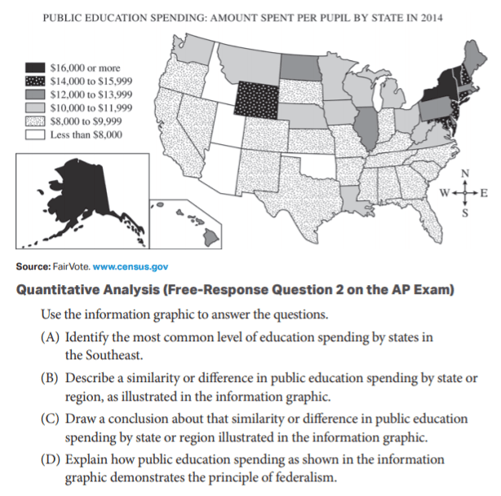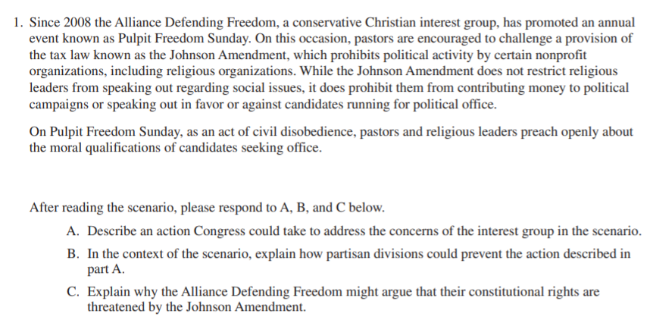
Free-response questions, or FRQs, on the AP US Government exam are more straightforward than those on some other AP tests, but they can still be tough if you're not ready for them. In this guide, we will lay out a simple step-by-step method for answering AP Government FRQs, go through a real example, and tell you where you can find additional practice resources.
AP Government Free-Response Section Format
The free-response section lasts one hour and 40 minutes and consists of four questions, each of which is worth 12.5% of your total score. So as a whole, the free-response section accounts for half your total AP Gov score (the other 50% comes from the multiple-choice section). Each FRQ is worth 3-6 raw points.
Here are the four types of FRQs you'll get on the AP Government exam:
- Concept Application (3 raw points)
- Quantitative Analysis (4 raw points)
- SCOTUS Comparison (4 raw points)
- Argument Essay (6 raw points)
The free-response questions will ask you to integrate your knowledge of the various content areas covered by the course. This includes analyzing political events in the US, discussing examples, and demonstrating your understanding of general principles of US government and politics. You'll also be asked to examine data from charts, define key terms, and explain the roles that different parts of our government play in the political system.
The following chart shows specifically what you must do for each FRQ on the AP Government test. All info below comes from the 2020 AP US Government and Politics Course and Exam Description.
| Free-Response Question | Purpose and Assessment |
| 1. Concept Application | Presents students with an authentic scenario. Assesses student ability to describe and explain the effects of a political institution, behavior, or process. Additionally, this question assesses student ability to transfer understanding of course concepts and apply them in a new situation or scenario. |
| 2. Quantitative Analysis |
Presents students with quantitative data in the form of a table, graph, map, or infographic. This question assesses students' ability to perform the following:
|
| 3. SCOTUS Comparison |
Presents students with a description of a non-required Supreme Court Case and its holding. This question assesses students' ability to do the following:
|
| 4. Argument Essay |
Assesses students' ability to do the following:
|
AP Government FRQs: 5-Step Solution Process
This section provides a step-by-step process for answering any question on the AP US Government exam. Here's a sample question from the 2020 AP Gov Course and Exam Description that I'll reference throughout so you can see how these steps might work in practice:

Step 1: Read the Introductory and Concluding Sentences
Free-response questions #1 and #3 will include passages, while question #2 will have an image or a chart with data. Skim the first and final sentences of the passage (or title of the graphic for #2) before you get to the tasks (labeled A-C or A-D). This will help you get a rough sense of what to expect in the rest of the question.
It's a good idea to read the intros and conclusions to all the FRQs before choosing which one to begin with. Doing this might help build up your confidence and improve your efficiency to start with a question that's easier for you.
In the sample question above, you would read the title of the graphic ("Public Education Spending: Amount Spent per Pupil by State in 2014") and then skim the image itself to get a sense of what it's asking you to analyze.
 Time to look for clues in your AP Gov FRQs. (Hey, that rhymed!)
Time to look for clues in your AP Gov FRQs. (Hey, that rhymed!)
Step 2: Identify (and Underline, If You Want) the Command Verb
For each task in each FRQ, you're given specific instructions on the type of answer that is expected; these instructions include command verbs that tell you what to do. It's important to be aware of exactly what the question is asking so you can earn full points.
These command verbs are the first words you should zero in on as you approach a question. If you think it'll help keep you focused, you can underline these verbs.
Here are the most commonly used task verbs, as described in the AP Gov Exam Description:
Compare: Provide a description or explanation of similarities and/or differences.
Define: Provide a specific meaning for a word or concept.
Describe: Provide the relevant characteristics of a specified topic.
Develop an argument: Articulate a claim and support it with evidence.
Draw a conclusion: Use available information to formulate an accurate statement that demonstrates understanding based on evidence.
Explain: Provide information about how or why a relationship, process, pattern, position, situation, or outcome occurs, using evidence and/or reasoning. Explain "how" typically requires analyzing the relationship, process, pattern, position, situation, or outcome, whereas explain "why" typically requires analysis of motivations or reasons for the relationship, process, pattern, position, situation, or outcome.
Identify: Indicate or provide information about a specified topic, without elaboration or explanation.
In part A of the sample question, the command verb is "identify," indicating that you need to correctly interpret the data in the image. In part B, the command verb changes to "describe," which means you'll need to go one step further and interpret and analyze data in the graphic that you have found.
Part C starts with "draw a conclusion," meaning that you will need to tie together the evidence you found in part B to come up with a final (accurate) statement on what this means. Finally, part D begins with the task verb "explain," showing that you must make a clear connection between the data in this graphic as a whole and the principle of federalism.
Step 3: Know Where You'll Earn Your Raw Points
In general, each part in a question (A, B, C, and D) will correspond to 1 raw point, but not all questions are like this.
After finding the task verb in the part of the question you're answering, take note of how many examples or descriptions you need to provide, as each will likely correspond to a point in your raw score for the question. There might also be more than one task verb in a question, in which case you'll likely get at least 2 raw points for it.
As a reminder, here is the maximum number of raw points you can earn for each question (don't forget that each question is still worth the same percentage of your score: 12.5%):
- Concept Application (3 raw points)
- Quantitative Analysis (4 raw points)
- SCOTUS Comparison (4 raw points)
- Argument Essay (6 raw points)
Take care to answer the question thoroughly but directly, addressing all points in a way that will make it easy for graders to assess your response. Remember that you don't need to write an essay for the first three FRQs, so just go straight for the answer to avoid any ambiguity.
In the sample question, we know there will be 4 raw points you can earn. And since the tasks are divided into four parts (labeled A-D), we can assume that each part will be worth 1 raw point.
You can see more sample FRQs and how they're graded with the official scoring guidelines here.
Step 4: Reread Your Answer
Once you've come up with an answer, reread what you wrote to ensure it makes sense and addresses the question completely. Did you give the correct number of descriptions or examples asked of you? Does your answer directly respond to what the question is asking?
If you're satisfied, move on to the next part of the question and return to step 2!
Step 5: Pace Yourself
The final step is to keep track of time so you can be sure you're pacing yourself effectively and are not spending too much time on any one question. As a reminder, you'll have one hour and 40 minutes for the entire free-response section of the AP Government exam.
It's suggested that you spend the following amounts of time on each FRQ:
| AP Government Free-Response Questions | Suggested Time |
| FRQ #1: Concept Application | 20 minutes |
| FRQ #2: Quantitative Analysis | 20 minutes |
| FRQ #3: SCOTUS Comparison | 20 minutes |
| FRQ #4: Argument Essay | 40 minutes |
As you can see, you should spend about an equal amount of time on the first three FRQs and save most of your time for your essay, which will likely require the most effort of the four.
 The United States Capitol (Martin Falbisoner/Wikimedia Commons)
The United States Capitol (Martin Falbisoner/Wikimedia Commons)
A Real AP Government FRQ Example + Analysis
Now, let's go through the answers to a real AP Government free-response question from the 2019 released questions to show you what your responses should look like. This question is an example of a Concept Application question on the exam, meaning it's worth 3 raw points (1 point each for parts A, B, and C).

This question is all about the Johnson Amendment, which does not allow religious organizations to engage in political activities and contribute money to political campaigns. As this passage explains, the Alliance Defending Freedom, a religious group, encourages pastors to challenge this law by participating in an annual event called Pulpit Freedom Sunday.
Below, we go through how to answer each of the three parts correctly using the scoring guidelines.
Part A—1 Point
Part A asks you to come up with an example of a specific action Congress could take to address the concerns of the Alliance Defending Freedom. In other words, what could Congress do to allow groups such as the Alliance Defending Freedom to speak freely about political campaigns?
Note that the command verb used here is "describe," meaning you must "provide the relevant characteristics of a specified topic," or elaborate on what you're proposing and why it would work.
There are two possible answers you could put down here, according to the scoring guidelines:
- Congress could pass a law that would reverse the Johnson Amendment.
- Congress could pass a law to allow religious organizations to participate more directly in politics.
Part B—1 Point
Part B asks you to go into more detail about what you proposed in part A. You must talk about how partisan divisions (i.e., differences in political parties among politicians) could stop whatever you proposed in part A from going into effect (whether that's a new law altogether or a reversal of the original Johnson Amendment).
The task verb used here is "explain," so you must use evidence to show how the action you wrote down in part A could be blocked or reversed.
Here are two possible answers, according to the scoring guidelines:
- Partisan divisions make it more difficult to pass a law because parties adhere to different ideological points of view.
- If Congress and the president are from different political parties, the president might threaten to veto the legislation.
Part C—1 Point
The final part of this free-response question asks you to examine the scenario again, this time from the perspective of the Alliance Defending Freedom, or the religious group in question.
How might the Alliance argue that the Johnson Amendment, which prevents them from speaking on political issues and contributing money to political campaigns, is taking away their rights?
The key here is to first think about what rights these could be. Perhaps freedom of speech or freedom of religion? As you probably noticed, the task verb is "explain," so once again you must use plenty of evidence to show why this contentious relationship exists between the Alliance and the Johnson Amendment/the US government as a whole.
Here are examples of answers you could write, according to the official scoring guidelines:
- The Alliance Defending Freedom and other religious groups might argue that their First Amendment rights are being violated.
- The Alliance Defending Freedom and other religious groups might argue that their freedom of speech/religion is being violated.

Essential Resources for Practicing AP US Government FRQs
There are several resources you can use to hone your skills for answering AP Government FRQs.
Official College Board Resources
The College Board website hosts free-response questions from previous tests that you can use for practice. I recommend starting with the 2019 FRQs (unfortunately, they don't come with sample student responses), as these will look the most like the questions you'll get on test day.
Once you've used those, you can look at FRQs from the 2018 test and earlier; most of these come with sample student responses so you can see what a good response looks like.
If you're hoping to practice FRQs in the context of a full-length test, here are some links to past AP Government exams you can download (as always, prioritize the most recent tests):
- 2018 Practice Test
- 2013 Practice Test
- 2012 Practice Test
- 2009 Practice Test
- 2005 Practice Test
- 1999 Practice Test
These are by far the best sample AP US Government free-response questions you can get because they most accurately represent what you'll see on the real test.
AP Government Review Books
AP Government review books are also solid resources for free-response practice, though they vary a lot in quality.
The Princeton Review's prep book for AP Gov includes five full-length practice tests, so there should be tons of free-response questions you can use to hone your skills. Barron's AP US Gov review book also has some useful practice tests and free-response questions.
If you use these unofficial free-response questions for practice, just be sure to intersperse them with official questions from the College Board so that you maintain an accurate sense of what to expect on the real test.
 Review books can be great resources for free-response and multiple-choice practice questions, and for finding test-taking strategies you might not have discovered on your own.
Review books can be great resources for free-response and multiple-choice practice questions, and for finding test-taking strategies you might not have discovered on your own.
Recap: Everything to Know About AP US Government FRQs
The four free-response questions on the AP US Government and Politics exam can be approached methodically to earn the maximum number of points.
Read the intro and conclusion to the question first so you can get your bearings. Then, for each of the separate parts, identify the task verb, figure out where you'll earn your raw points, and double-check your answer for any missing pieces or careless errors.
You should also pace yourself so that you're spending no more than 20 minutes each on the first three questions and 40 minutes on the essay.
I suggest practicing at least a few free-response questions before heading into the AP exam. The best resource to use is the College Board website, which contains an archive of past questions accompanied by scoring guidelines and sample student responses. These questions are pretty simple compared to the free-response questions on other AP tests once you get the hang of them!
What's Next?
Not sure where to begin in your AP prep? Our five-step plan will prepare you to take on any AP test.
If you're missing some of your notes that you need to study for AP Gov, check out this article with links to all the content you need to know for the test. You can also learn about the test as a whole with our comprehensive AP Government and Politics review guide.
Do you have a target score in mind for this exam? Learn more about what it takes to earn a 5 on an AP test and whether you should aim for one yourself.
These recommendations are based solely on our knowledge and experience. If you purchase an item through one of our links, PrepScholar may receive a commission.
Have friends who also need help with test prep? Share this article!

Samantha is a blog content writer for PrepScholar. Her goal is to help students adopt a less stressful view of standardized testing and other academic challenges through her articles. Samantha is also passionate about art and graduated with honors from Dartmouth College as a Studio Art major in 2014. In high school, she earned a 2400 on the SAT, 5's on all seven of her AP tests, and was named a National Merit Scholar.



































 Holly R.
Holly R.